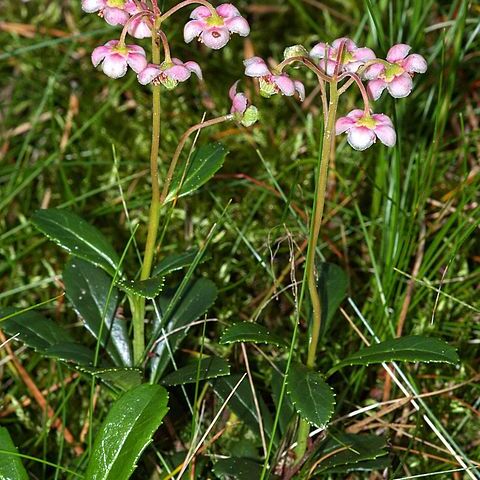Subshrubs, chlorophyllous, autotrophic. Stems erect, rarely decumbent, glabrous or papillose to hispidulous, especially distally. Leaves cauline, alternate or pseudoverticillate in 2-5(-6) whorls; petiole present; blade maculate or not, lanceolate, elliptic-lanceolate, ovate-lanceolate, oblong-lanceolate, ovate, lanceolate-oblong, oblanceolate, elliptic, or spatulate, coriaceous, margins entire, serrulate, serrate, or crenate-serrate, revolute, surfaces glabrous or papillose. Inflorescences corymbs or subumbels, rarely solitary flowers, not lax in bud or flower, erect in fruit, (symmetric); peduncular bracts absent; inflorescence bracts adnate to pedicels, sometimes scarcely so. Pedicels erect in fruit, (glabrous or papillose to hispidulous); bracteoles absent. Flowers radially symmetric, nodding or spreading; sepals 5, connate proximally, often obscurely so, calyx lobes ovate, broadly ovate, or suborbiculate; petals 5, distinct, white, pink, or rose, often tinged violet, without basal tubercles, (surfaces glabrous), corolla rotate to crateriform or broadly crateriform; intrastaminal nectary disc present; stamens 10, included; filaments broad proximally, abruptly narrowed medially, slender distally, dilated basal portions ciliate or villous to densely villous; anthers oblong, without awns, with tubules, dehiscent by 2 crescent-shaped to round pores; pistil 5-carpellate; ovary imperfectly 5-locular; placentation intruded-parietal; style (included), straight, expanded distally; stigma entire or obscurely 5-ridged, without subtending ring of hairs. Fruits capsular, erect, dehiscence loculicidal, no cobwebby tissue exposed by splitting valves at dehiscence. Seeds ca. 1000, fusiform, winged. x = 13.
More
Pet 5, spreading; filaments strongly dilated below the slender tip; anthers plump, the pollen-sacs flattened-oblong, attached at the middle, rounded at the base, connate below the filament, separate and tapering above, opening by a wide terminal pore; style very short, nearly immersed in the depressed top of the ovary; capsule depressed-globose, loculicidal from the top down; low, perennial, evergreen half-shrubs from a creeping rhizome, with thickish, denticulate, opposite or often subverticillate, wholly cauline lvs and terminal, long-peduncled, few-fld umbels or corymbs of white or pink fls. 4–5/N. Hemisphere.
Herbs perennial, decumbent or shrubs dwarf, erect, evergreen. Leaves opposite or subverticillate, shortly petiolate, often crowded; leaf blade leathery, margin serrate. Flowers solitary, terminal, or 1 or 2 on simple or branched, bracteate peduncles, nodding, regular. Sepals 5, persistent. Petals 5, concave. Filaments pilose; anthers opening by pores. Ovary depressed-globose, 5-locular; style obconic, straight, very short. Capsules depressed-globose, long persistent, erect. n = 13.

